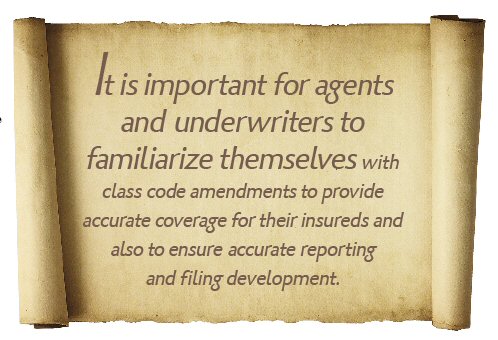WORKERS COMPENSATION CLASS CODES: PAST AND PRESENT
Today’s sophisticated system has its roots in the Code of Hammurabi
By Daniel Rahl
What’s my rate? It’s a question that every insured has likely asked, and every agent or underwriter must answer. But how do insurers know? The answer lies in the system of risk exposure classification that’s been developed over the course of several millennia.
Classification codes are such a commonplace fixture of the insurance rating system that they may be taken for granted. Nowadays they serve as standard definitions of business operations; in other words, risks. However, this bland, unassuming little collection of numbers has its origins in ancient times. One of the earliest known texts related to compensation for injury is the Code of Ur-Nammu, written between 2100 and 2000 BCE. King Ur-Nammu, ruler of the ancient Sumerian city-state of Ur, prescribed that specific amounts be paid based on the anatomic location of an injury. Later, between 1795 and 1750 BCE, Hammurabi dictated his famous (or infamous) version of compensation.
While his “eye for an eye” edict is best known, he also provided for payments to be made based on the kind and severity of injuries. Even the Pirate Code, as set down by Henry Morgan and Bartholomew “Black Bart” Roberts (among others), provided for compensation based on severity/anatomic location of crew members’ injuries.
 These early schedules of compensatory rates were either hyper-specific or remarkably vague, leaving room for interpretation in either direction. Fast forward several thousand years, and you find a sophisticated system of classification tailored to virtually every conceivable kind of occupation. This amazing granularity allows insurers to provide infinitely more accurate compensatory rates than those primitive doctrines. Agents and underwriters can define each business based on its primary operation and assign it the corresponding classification. These codes in turn are assigned the rates we’ve come to know and love. As a result, all injured employees of a business are afforded equal compensation. Or are they?
These early schedules of compensatory rates were either hyper-specific or remarkably vague, leaving room for interpretation in either direction. Fast forward several thousand years, and you find a sophisticated system of classification tailored to virtually every conceivable kind of occupation. This amazing granularity allows insurers to provide infinitely more accurate compensatory rates than those primitive doctrines. Agents and underwriters can define each business based on its primary operation and assign it the corresponding classification. These codes in turn are assigned the rates we’ve come to know and love. As a result, all injured employees of a business are afforded equal compensation. Or are they?
Despite being incredibly comprehensive, this system sometimes doesn’t quite fit the bill, and a single classification is insufficient for a particular business. It is critical, then, that policy writers be familiar with the sundry exceptions, amendments, and appellations that may be affect basic classifications, as well as their downstream effects on premium.
To provide additional definition for a risk, an agent or underwriter might employ codes referred to as standard exceptions. These codes cover operations common to most businesses (such as clerical work) that may not otherwise be related to the primary operations of the business. For example, the office staff of an HVAC business likely will not be involved in installation, repair, or maintenance operations. Therefore, the office staff is not exposed to the same hazards as the HVAC technicians. As a result, an underwriter or agent may classify those employees as a clerical exposure, which probably would carry a lower rate. This is certain to make a policy’s annual premium more attractive than if all employees were classified under an HVAC technician code.
Sometimes employees classified under a code may be subject to hazards beyond those commonly associated with that classification. These might include disproportionate exposure to abrasives/silica, asbestos, coal or coal dust, foundry environments, or atomic radiation. These exposures are rated using an additional disease loading factor to increase the premium proportionate to the hazard.
An example is a ship hull painting business that has select employees who are regularly engaged in sandblasting operations. These employees would be subject to an extraneous silica hazard, and their portion of the business exposure would be rated using the associated silicosis loading factor. These disease loading factors have implications beyond the basic class premium, as the additional premium developed is often summed separately, and its use as a basis for downstream premium elements may differ from that of the basic class premium.
Some classes have prescribed appellations or applications. For instance, in some states certain codes require the application of a loading factor. These loading factors account for exposure to injurious hazards, like the aforementioned disease loading factors, or potential catastrophic losses. Some examples are pilots and flight crews or explosives or ammunition manufacturing. Because inherent risks are specific to these occupations, these are mandatory loading factors. The exposure subject to this loading factor may be defined separately from the basic exposure, which would be reported under a separate statistical code along with the subsequent premium. The premium for the basic class code is considered a ratable code, or subject to experience or retrospective rating, and the premium generated by the loading factor is considered non-ratable, or not subject to experience or retrospective rating.
There are certainly other idiosyncrasies of the classification that may be considered, such as the pertinence of legislative acts or variations of premium bases. Each of these plays an important role in the premium development of every policy and also in establishing accurate future actuarial or claims data. These issues can definitely affect a carrier’s bottom line. This may be especially critical for smaller carriers that specialize in niche markets in which these particular hazards are more prevalent (such as shipping operations, laboratories, foundries, and so forth).
It is important for agents and underwriters to familiarize themselves with these class code amendments to provide accurate coverage for their insureds and also to ensure accurate reporting and filing development.
The author
Daniel Rahl is senior business systems analyst at NetRate Systems and has been with NetRate for more than 10 years. Most recently he served as an analyst and quality assurance expert on the workers compensation team. He assisted in analyzing all of the NCCI and bureau rules and guidelines for 46 states and the District of Columbia.





